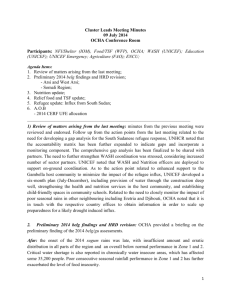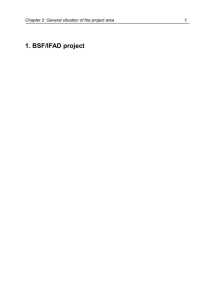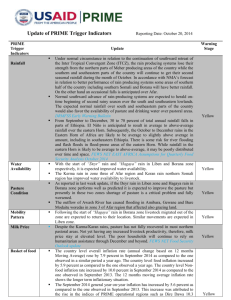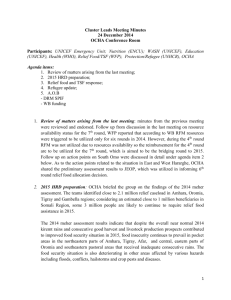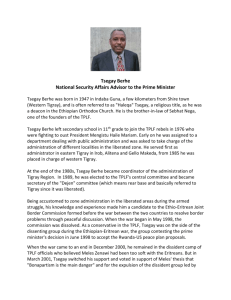Ethiopia Site Selection Report
advertisement
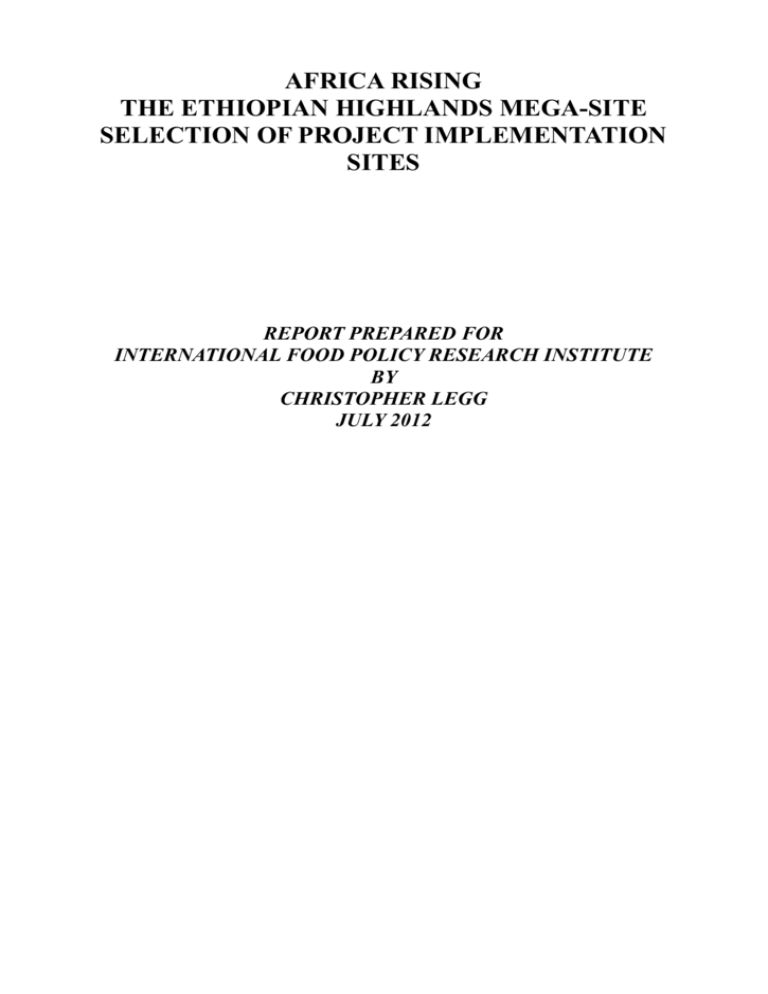
AFRICA RISING THE ETHIOPIAN HIGHLANDS MEGA-SITE SELECTION OF PROJECT IMPLEMENTATION SITES REPORT PREPARED FOR INTERNATIONAL FOOD POLICY RESEARCH INSTITUTE BY CHRISTOPHER LEGG JULY 2012 Introduction The Africa RISING project of the Feed the Future Initiative proposes to initiate and test interventions to enable sustainable intensification of agriculture in three major regions of Africa by working in “mega-sites” which exemplify the main climatic and human characteristics of these regions. The Highland wheat-producing are of Ethiopia has been selected as representative of extensive densely populated highland areas of east Africa, and results of the initial project will be capable of extrapolation to wide areas of East Africa, as shown in Figures 1 and 2. This report analyses and stratifies the Ethiopian Highland mega-site, and present recommendations for selection of operational sites within the mega-site. Figure 1. Extrapolation zones for the three African Mega-Sites Figure 2. Extrapolation zones for the Ethiopian Highlands Mega Site in East Africa Background to the Mega-Site According to Version 3 of the Concept Note for the Ethiopian Highlands Mega-Site (which may be superseded by a modified concept note) “The integrated research will focus on the wheat-growing area in the Ethiopian Highlands. This area exhibits large variations in existing levels of intensification, cereal-legume rotations and other crop-combinations, as well as crop-livestock integration. Furthermore, the factors driving intensification such as agricultural potential, access to available technologies, demand for livestock products, and integration with markets vary a lot within the area. A number of study sites will be chosen from these wheat-growing areas. They will represent contrasting levels of intensification to enable the characterization of different trajectories and identification of technology combinations that lead to sustainable development pathways. The delineation of the study sites will be done on the basis of political/administrative boundaries (several woredas). The size will be large enough to encompass a range of biophysically defined areas with contrasting farming systems and a range of social institutions. A more in-depth characterization of the study sites and the entire target zone will form part of further targeting and out-scaling during the project life. This will include a variety of data at different scales and a richer interpretation of household level socioeconomic data.” Figure 3. Topography of Ethiopian Highlands Figure 4. Rainfall in Ethiopian Highlands Figure 5. Population distribution in Ethiopian Highlands Figure 6. Access to markets in Ethiopian Highlands Description of Mega-Site As shown in Figures 3 to 6, the Ethiopian Highlands are extremely diverse topographically, climatically and in respect of population distribution and accessibility of markets. In general, wheat is produced in areas with more than 600mm annual rainfall and at elevations of greater than 1700 metres. There is a crude vertical zonation of cereal crops, from maize at lowest elevations, through teff at medium elevations, then successively wheat and barley at highest elevations. The variation in elevation and rainfall within single woredas can be extreme. Many woredas are quite large, often more than 1500 square kilometres, and elevation ranges of more than 1500 metres in a single woreda are not uncommon. Orographic and “rain shadow” effects certainly result in great variation in annual rainfall within single woredas, although this is not captured in sufficient detail in available rainfall maps. Stratification of the Mega-Site The first phase of stratification is to identify those woredas where wheat constitutes a significant proportion of the total cereal crop area. A figure of 25% of the total cereal crop area was taken as the cut-off for this targeting study. Out of a total of 656 woredas in the 2008 agricultural atlas, 113 had significant wheat production. USAID and the Ethiopian Government agree that priority should be given in Africa RISING to AGP (Agricultural Growth Plan) woredas. Out of a total of 84 AGP woredas, 19 coincided with wheat-growing woredas. After some discussion, it has been agreed that, while AGP woredas should be targeted preferentially, other non-AGP woredas could be included to fill significant gaps in targeting. The locations of woredas with significant wheat and of AGP woredas are shown in Figures 8 and 9. Figure 7. Combination of population density and market access Figure 8. Cereal cropping systems, Woredas with significant wheat, Ethiopian Highlands Figure 9. Distribution of AGP Woredas, Ethiopian Highlands Table 1. Class limits for stratification Class Elevation Rainfall Slope Population TLU/percap Access 1 <1800 m < 900 mm <3 deg < 100 /km2 < 0.5 percap Very good 2 1800-2400m 900-1100 3-5 deg 100 - 200 0.5 – 1.0 good 3 > 2400 m > 1100 mm > 5 deg > 200 /km2 > 1.0 percap moderate 4 poor Following the initial selection of wheat-producing woredas, further stratification is undertaken on the basis of elevation, rainfall and population density. It is apparent that the large size and extreme topography of many woredas make the use of mean elevation and rainfall problematic, but there is little alternative for this “first-pass” stratification. The mean elevation and rainfall of a woreda may not accurately represent the main cropped areas in the woreda. In some cases the main cultivated areas may be on a plateau at the upper elevation limit of a woreda, while in other most cultivation may occur in lower valleys. Once the initial selection of target woredas is agreed, a further stratification will be undertaken at Keballe level, where the variation within each Keballe will be less than in the larger Woredas. Stratification on the basis of elevation, rainfall and population density results in 14 distinct classes, as shown in Table 2. Nine of these classes include significant (more than 4) numbers of woredas, so these should all be targeted in order to include the full spectrum of variability in the mega-site. Implications for Site Selection. Within each of the nine significant elevation-rainfall-population classes, target woredas have been selected as shown in Table 2 and figure 10. Three further criteria were used to select targets. Market access had to be good to moderate, and livestock density had to be moderate to high. Where there was choice between different cereal cropping systems, those with the most significant wheat production were chosen. Where an AGP woreda existed in a class and met these additional criteria, it was automatically selected. In a few cases, AGP woredas within classes did not meet all of the additional criteria, so these are marked as possible targets depending on how strictly the AGP woreda rule is interpreted. Some elevation-rainfall-population classes are not represented by AGP woredas. This is especially true of the lower elevation classes. In these cases new non-AGP woredas need to be targeted to ensure coverage of the full spectrum of possible variation. The target woredas suggested represent the best possible combination of all factors considered in the selection, but these are not the only possible targets to ensure coverage of the spectrum of variation. Alternative woredas can be selected based on the data presented in Table 2 if these better satisfy other criteria such as presence of research centres, existing partnerships and other socio-economic factors. The majority of the suggested target woredas are in Oromia region, but two are in Tigray and two in SNNPR. If necessary for political reasons, and alternative site could be selected in Amhara. Table 2. Classification of Wheat Producing Woredas and Target Identification Woreda Zone Cereals AGP elevation el_range mean rainfall slope popdens ACCESS TLU_PERCAP elev_class rain_class slope_class pop_class tlu_classcategory Targets Minjarna Shenkora North Shewa (K3) Teff-wheat 0 1567 1498 3.21 781 87 2 0.71 1 1 2 1 2 A Merti Arsi Maize-wheat 0 1743 2132 2.95 853 98 2 1.04 1 1 1 1 3 A Ziway Gugda Arsi Maize-wheat 0 1787 669 2.48 786 90 2 1.03 1 1 1 1 3 A Legehida Bale Teff-maize 0 1243 1124 2.52 666 10 3 0.90 1 1 1 1 2 A Seweyna Bale Teff-maize 0 975 1698 1.12 538 6 5 0.80 1 1 1 1 2 A Arsi Negele East Shewa Maize-wheat 0 1795 1493 1.45 783 139 1 0.86 1 1 1 2 2 A Goro Bale wheat 0 1516 1710 2.77 837 33 2 0.87 1 1 1 1 2 A potential Guradamole Bale wheat 0 1116 1994 3.10 652 5 4 1.21 1 1 2 1 3 A Mennana Arena Buluk Bale Teff-wheat 0 1370 3183 2.84 793 16 4 1.07 1 1 1 1 3 A Odo Shakiso Borena Teff-wheat 0 1530 1376 3.45 743 30 3 1.03 1 1 2 1 3 A Yabelo Borena Maize-wheat 0 1528 1042 1.91 552 14 2 1.40 1 1 1 1 3 A Ginir Bale wheat 0 1720 1410 2.16 974 53 3 0.97 1 2 1 1 2 B potential Amigna Arsi Wheat-teff 0 1713 1608 3.82 958 51 4 1.30 1 2 2 1 3 B Seru Arsi wheat 0 1648 1625 5.69 965 46 4 1.29 1 2 3 1 3 B Gololcha Bale Wheat-barley 0 1648 1672 3.78 965 75 3 0.62 1 2 2 1 2 B Gidami West Wellega Maize-wheat 0 1053 1843 3.81 1087 35 5 0.32 1 2 2 1 1 B Ahferom Central Tigray Teff-wheat 0 1925 1343 3.66 640 125 2 0.56 2 1 2 2 2 C Gulomahda Easetern Tigray Wheat-barley 0 2309 1053 4.97 574 161 1 0.46 2 1 2 2 1 C Hawzen Easetern Tigray Barley-wheat 0 2055 1122 2.88 625 135 1 0.56 2 1 1 2 2 C Wukro Easetern Tigray Wheat-barley 0 2135 828 3.22 607 114 1 0.51 2 1 2 2 2 C Degua Temben Central Tigray Wheat-teff 0 2154 1336 6.07 649 109 1 0.61 2 1 3 2 2 C Enderta Southern Tigray Wheat-barley 0 2149 1050 3.40 576 97 1 0.56 2 1 2 1 2 C Samre Southern Tigray Teff-wheat 0 1817 1258 4.21 639 71 2 0.91 2 1 2 1 2 C Hintalo Wajirat Southern Tigray Wheat-teff 0 2146 2018 5.30 575 83 2 0.68 2 1 3 1 2 C Ofla Southern Tigray Wheat-barley 1 2383 1964 7.30 772 147 2 0.54 2 1 3 2 2 C AGP targe Jijiga Jijiga Wheat-barley 0 1803 1027 2.00 745 107 2 0.46 2 1 1 2 1 C Dodotana Sire Arsi Wheat-teff 0 1880 1541 2.45 865 134 1 0.73 2 1 1 2 2 C Dodotana Sire Arsi Wheat-teff 0 1880 1541 2.45 865 134 2 0.73 2 1 1 2 2 C Jarso East Harerghe Wheat-maize 0 2006 1603 5.58 803 215 2 0.47 2 1 3 3 1 D Kurfa Chele East Harerghe Maize-wheat 0 2043 1739 5.54 853 219 1 0.37 2 1 3 3 1 D Bedeno East Harerghe Maize-wheat 0 1841 1998 7.08 864 236 2 0.51 2 1 3 3 2 D Lanfero Guraghe Maize-wheat 0 1836 711 1.42 888 220 2 0.84 2 1 1 3 2 D Hagere Mariamna Kesem North Shewa (K3) wheat 0 2367 2016 6.50 909 77 3 0.85 2 2 3 1 2 E Agarfa Bale Wheat-barley 1 2356 2391 5.24 1035 73 3 1.23 2 2 3 1 3 E Nenesebo Bale Barley-wheat 0 2330 1940 6.02 1061 37 3 1.49 2 2 3 1 3 E Debark North Gonder Barley-wheat 0 2054 2973 6.99 919 102 3 0.55 2 2 3 2 2 F Dabat North Gonder Teff-wheat 0 1918 1830 5.88 940 128 2 0.63 2 2 3 2 2 F Wegera North Gonder Wheat-barley 0 2167 1888 4.91 1004 125 3 0.58 2 2 2 2 2 F Sayint South Wollo Teff-barley 0 2303 2921 8.50 1085 112 4 0.78 2 2 3 2 2 F Debresina South Wollo Wheat-teff 0 2194 2316 7.76 1055 173 3 0.83 2 2 3 2 2 F Jama South Wollo Teff-wheat 0 2362 1232 6.25 1029 123 1 0.72 2 2 3 2 2 F Moretna Jiru North Shewa (K3) Teff-wheat 0 2092 1373 8.50 922 144 2 0.45 2 2 3 2 1 F Siya Debirna Wayu & EnsaroNorth Shewa (K3) Teff-wheat 0 2340 1425 4.47 925 141 2 0.50 2 2 2 2 2 F Yaya Gulelena Debre LibanosNorth Shewa (K4) Teff-wheat 1 2353 1361 4.96 1007 175 3 0.71 2 2 2 2 2 F Jeldu West Shewa Wheat-barley 0 2251 1802 6.06 1087 150 3 0.97 2 2 3 2 2 F Gimbichu East Shewa Wheat-teff 1 2283 1008 3.22 939 108 2 0.77 2 2 2 2 2 F Akaki East Shewa Teff-wheat 0 2073 1102 2.13 969 103 1 0.83 2 2 1 2 2 F Kersana Kondaltiti West Shewa Teff-wheat 0 2307 1736 2.67 1070 114 2 0.81 2 2 1 2 2 F Aseko Arsi Barley-wheat 0 2279 1778 8.46 1074 128 3 0.92 2 2 3 2 2 F Chole Arsi Wheat-barley 0 2385 2295 7.90 1070 142 3 0.81 2 2 3 2 2 F Sude Arsi Wheat-teff 0 2330 1527 5.84 1093 114 3 0.96 2 2 3 2 2 F Robe Arsi Wheat-teff 0 2132 2700 5.20 1099 121 3 1.02 2 2 3 2 3 F Shirka Arsi Wheat-teff 1 2233 2370 5.27 1039 142 2 1.09 2 2 3 2 3 F Gasera Bale wheat 1 2140 1312 4.71 1099 138 3 0.54 2 2 2 2 2 F AGP targe Mojana Wadera North Shewa (K3) wheat 1 1991 2240 6.93 1040 150 2 0.34 2 2 3 2 1 F Kersa East Harerghe Maize-wheat 0 2117 1360 4.35 903 357 1 0.44 2 2 2 3 1 G WEREDA 19 Zone 3 Teff-wheat 0 2224 275 2.08 1041 3439 1 0.05 2 2 1 3 1 G WEREDA 26 Zone 6 Teff-wheat 0 2173 214 1.12 1007 586 1 0.21 2 2 1 3 1 G WEREDA 27 Zone 6 Teff-wheat 0 2116 113 1.20 986 1808 1 0.11 2 2 1 3 1 G Limu Hadiya Wheat-maize 1 2166 1200 2.59 1029 411 2 0.59 2 2 1 3 2 G AGP targe Menjiwo Kaffa Teff-wheat 0 2145 2116 7.22 1750 96 3 0.81 2 3 3 1 2 H Gera Jimma Wheat-maize 1 2124 1588 3.95 1876 68 3 0.99 2 3 2 1 2 H Gesha Daka Kaffa Teff-wheat 0 2221 808 2.12 1929 45 4 0.50 2 3 1 1 2 H Goncha Siso Enese East Gojam Teff-wheat 0 2252 2002 6.15 1234 141 2 0.59 2 3 3 2 2 J Enarj Enawga East Gojam Teff-wheat 0 2316 2800 6.44 1193 173 2 0.62 2 3 3 2 2 J Kedida Gamela Kembata Alaba Tembaro Wheat-teff 0 2048 920 3.64 1107 614 2 0.42 2 3 2 3 1 J Kacha Bira Kembata Alaba Tembaro Wheat-teff 0 1993 1268 3.56 1252 544 1 0.47 2 3 2 3 1 J Yem Yem Special Woreda Teff-wheat 1 1902 1798 7.85 1246 115 2 0.67 2 3 3 2 2 J AGP poss Misha Hadiya wheat 0 2007 1876 3.18 1107 321 3 0.54 2 3 2 3 2 J potential Soro Hadiya wheat 0 1858 1954 4.08 1227 300 3 0.54 2 3 2 3 2 J potential Dedo Jimma Maize-wheat 0 1875 1983 5.62 1565 186 3 0.83 2 3 3 2 2 J Angacha Kembata Alaba Tembaro wheat 0 2265 967 2.99 1163 553 2 0.46 2 3 1 3 1 J Ganta Afeshum Easetern Tigray Barley-wheat 0 2457 1221 5.73 583 319 1 0.35 3 1 3 3 1 K Woreda Ganta Afeshum Atsbi Wenberta Ambalaje Endamehoni Gidan Janamora Adaba Endagagn Goba Dawunt Delanta Gera Midirna Keya Gabriel Mama Midirna Lalo Debre Berhan Zuria Berehna Aleltu Gedeb Sinanana Dinsho Hitosa Angolela Tera Tiyo Munessa Bekoji Dodola Lay Gayint Legambo Were Ilu Gishe Rabel Debay Telatgen Dendi Ejere (Addis Alem) WEREDA 28 Kokir Gedbano Gutazer Tena Degeluna Tijo Arbe Gona Hulla Chencha Omo Sheleko Telo Mesela Anfilo Sayo Zone Cereals Easetern Tigray Barley-wheat Easetern Tigray Barley-wheat Southern Tigray wheat Southern Tigray Wheat-barley North Wollo Barley-wheat North Gonder Barley-wheat Bale Wheat-barley Guraghe wheat Bale Barley-wheat North Wollo Teff-wheat North Shewa (K3) Wheat-barley North Shewa (K3) wheat North Shewa (K3) Barley-wheat North Shewa (K4) Wheat-teff Arsi wheat Bale Wheat-barley Arsi wheat North Shewa (K3) Barley-wheat Arsi wheat Arsi Wheat-barley Arsi Wheat-barley Bale Wheat-barley South Gonder Barley-wheat South Wollo Barley-wheat South Wollo Wheat-teff North Shewa (K3) Wheat-barley East Gojam Teff-wheat West Shewa Teff-barley West Shewa Teff-wheat Zone 3 Teff-wheat Guraghe Barley-wheat Arsi Wheat-barley Arsi Wheat-barley Sidama Maize-wheat Sidama Wheat-barley Gamo Gofa Barley-wheat Kembata Alaba Tembaro Teff-wheat Kaffa Teff-wheat West Harerghe Maize-wheat West Wellega Maize-wheat West Wellega Maize-wheat AGP elevation el_range mean rainfall slope popdens ACCESS TLU_PERCAP elev_class rain_class slope_class pop_class tlu_classcategory Targets 0 2457 1221 5.73 583 319 1 0.35 3 1 3 3 1 K 0 2478 1606 5.35 597 120 1 0.73 3 1 3 2 2 K 0 2468 2112 8.44 657 142 2 0.54 3 1 3 2 2 K 1 2607 1932 8.66 742 174 2 0.44 3 1 3 2 1 K AGP targe 0 2864 2126 8.11 899 143 2 0.65 3 1 3 2 2 K 0 2572 2898 8.34 918 90 4 0.59 3 2 3 1 2 L 1 2929 2327 5.20 1016 59 4 1.06 3 2 3 1 3 L 1 2527 676 2.74 1013 0 2 3 2 1 1 0 L AGP targe 0 2938 2827 6.19 1059 52 4 0.73 3 2 3 1 2 L 0 2538 2353 8.08 1000 120 3 0.77 3 2 3 2 2 M 0 2692 2018 7.52 1076 104 4 0.76 3 2 3 2 2 M 0 2666 1723 7.31 1049 132 2 0.72 3 2 3 2 2 M 0 2654 1938 5.86 977 114 2 0.84 3 2 3 2 2 M 0 2631 1435 2.71 1026 120 2 1.08 3 2 1 2 3 M 1 2604 1572 1.68 915 153 2 1.21 3 2 1 2 3 M 1 2743 2547 2.88 1050 104 2 0.88 3 2 1 2 2 M AGP targe 0 2644 2308 3.70 1050 191 2 0.71 3 2 2 2 2 M 0 2763 1484 3.26 958 104 2 0.81 3 2 2 2 2 M 0 2541 2086 4.29 1035 268 2 0.46 3 2 2 3 1 M 1 2429 2253 3.04 1001 129 3 1.15 3 2 2 2 3 M 1 2793 2547 3.43 1036 150 2 1.18 3 2 2 2 3 M 1 2776 1352 3.36 988 108 2 1.17 3 2 2 2 3 M 0 2411 2564 6.90 1100 151 3 0.52 3 3 3 2 2 N 0 3060 1877 6.25 1192 182 2 0.62 3 3 3 2 2 N 0 2661 1822 5.65 1118 151 2 0.79 3 3 3 2 2 N 0 2682 1522 7.56 1118 95 4 0.76 3 3 3 1 2 N 0 2848 1581 4.44 1375 193 2 0.68 3 3 2 2 2 N 1 2445 1661 3.89 1143 149 3 0.86 3 3 2 2 2 N AGP poss 0 2409 879 2.11 1116 160 2 0.74 3 3 1 2 2 N 0 2473 793 2.87 1100 724 1 0.21 3 3 1 3 1 N 0 2658 1562 4.30 1181 152 4 0.93 3 3 2 2 2 N 0 2724 2294 4.69 1103 176 2 0.90 3 3 2 2 2 N potential 0 2835 1641 2.63 1125 142 2 0.89 3 3 1 2 2 N potential 0 2553 1339 2.64 1311 410 3 0.88 3 3 1 3 2 N 0 2494 1487 3.52 1430 387 2 0.90 3 3 2 3 2 N potential 0 2491 1872 7.43 1349 323 1 0.53 3 3 3 3 2 N 0 1614 1795 6.26 1266 391 2 0.47 1 3 3 3 1 0 1995 2347 8.10 0 81 3 0.54 2 3 1 2 0 1753 1596 8.55 944 191 3 0.53 1 2 3 2 2 0 1138 1976 4.48 1177 45 4 0.21 1 3 2 1 1 0 1340 1739 4.53 1308 125 2 0.35 1 3 2 2 1 Figure 10. Classification of Woredas and recommended targets

